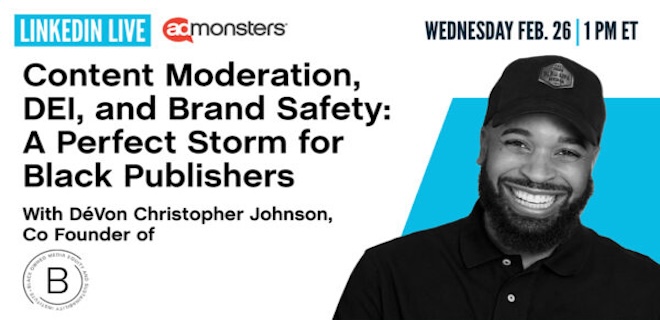
Shifting platform policies, evolving DEI priorities, and outdated brand safety tactics are creating challenges for Black-owned media and ad tech as a whole—here’s how publishers can thrive.
Meta’s latest content moderation shifts, the changing perception of DEI, and the ongoing debate over brand safety are reshaping the future of Black-owned media and the broader ad tech ecosystem.
In a recent AdMonsters LinkedIn Live, DéVon Christopher Johnson, Co-Founder of BOMESI, shared his perspective on how these forces impact diverse publishers, why relying on DEI-era funding was never a sustainable model, and how outdated brand safety tactics continue to sideline Black and Brown voices. Rather than seeing these challenges as roadblocks, Johnson emphasized the importance of adaptability, strategic investment, and pushing for a more inclusive media environment.
Here’s a recap of his insights on how publishers can not only survive but thrive.
Content Moderation Changes and Their Impact on Diverse Voices
To kick things off, Johnson acknowledged that algorithms and platform policies are constantly evolving, often in ways that prioritize the platform’s own interests over those of content creators.
Facebook’s latest changes didn’t shock him, as he sees such shifts as part of the company’s ongoing strategy to serve its own growth. Johnson points out that diverse media owners have long had to navigate an environment where major brands and platforms benefit from their intellectual property and audiences without necessarily supporting their success. Rather than being deterred, publishers should focus on adapting to these changes and doubling down on what works for their business.
On the topic of free speech, Johnson expresses a firm belief in the First Amendment, even when speech is unpleasant. While Johnson does not advocate for silencing voices, he distinguishes between free speech and harmful speech, emphasizing that social platforms should not allow content that causes actual harm. However, everyone should be cautious of supporting policies that platforms could one day use to suppress the voices of marginalized communities.
DEI Initiatives and Their Sustainability Beyond Funding
DEI is not the “hot commodity” it once was, but Johnson emphasizes that he never built his business on external financial sympathy. “If you built your business on sympathy, then you don’t have a real business,” he says.
He views the influx of funding in 2020 as a temporary correction rather than a sustainable model, recognizing that many took advantage of the moment. However, rather than relying on these funds, BOMESI used them strategically—to demonstrate the business case for reinvesting in diverse storytellers, amplifying Black, Brown, Asian, and LGBTQ voices.
Johnson acknowledges that some publishers are struggling now because they assumed the financial support would continue indefinitely. “Some thought the faucet would stay on forever, but America changes its mind quickly,” he notes. He believes that businesses that built strong foundations rather than depending on temporary funding thrive today.
Still investing in diversity is important. “If you can do math, then you know it’s good business to invest in diverse voices. If you’re choosing not to invest in future profits and consumers, you’re choosing racism—and we should call that out,” said Johnson.
Brand Safety Measures and Their Impact on Diverse Publishers
Beyond content moderation and DEI, Johnson also touched on an unfortunately sticky subject in digital media—brand safety.
Broad blocklists have long driven brand safety concerns by broad blocklists for publishers, where certain words automatically flag content as unsuitable for advertising—often without context.
For example, some advertisers might misinterpret a term like “slay” in fashion as violent, or “bomb” could mean something is both great and something more serious in a geopolitical context. These outdated and overly broad restrictions persist because people often expand these lists without reassessment. Johnson argues that marketers need to move beyond this lazy approach and engage in real contextual analysis.
“News” is not a monolith—what’s considered news in one community may be entirely different in another. Blanket bans on news content ignore cultural and contextual relevance, leading brands to miss valuable opportunities. Instead of avoiding entire categories, brands should take the time to understand the content, its audience, and its true context before making ad placement decisions.
Doubling Down on Media’s Power
It’s a pivotal time in media, especially with the White House now selecting press members instead of letting the press corps choose. As publishers, content creators, and storytellers, doubling down on our work is more crucial than ever.
“Joy itself can be a form of protest—we don’t always need to deliver bad news; sometimes, a smile is just as powerful. I’m committed to our work, the efforts of our BOMESI publishers and community, and the support of our partners. We must keep pushing forward because, although challenges arise, we’ll get through this moment,” said Johnson.